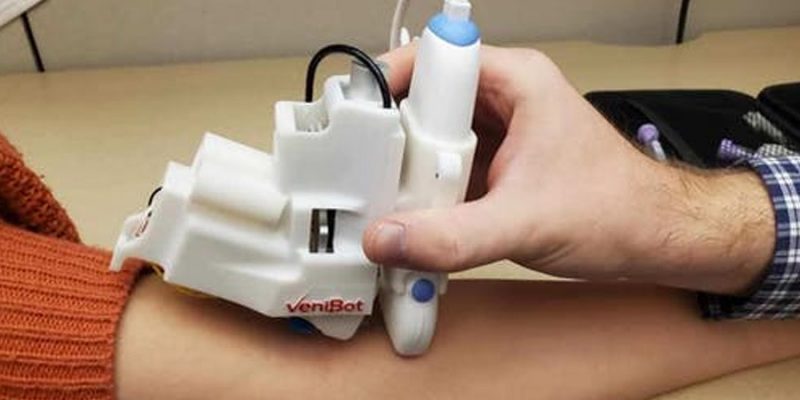
The next time you give a blood sample, the sample will be taken by a robot.
A robot fared as good as or better than humans in the first human clinical evaluation using an automated blood draw and screening system. Because the method yields quick findings, hospitals, and other healthcare personnel may be able to dedicate more time to treating patients. According to the statistics, 31 people met or exceeded clinical requirements, resulting in an overall success rate of 87 percent. The success rate for the 25 persons who had easy-to-access veins was 97 percent. As part of the device, an ultrasound image-guided robot gathers blood from veins. At the bedside, in ambulances, emergency rooms, pharmacies, physicians’ offices, and other locations, a highly integrated device with a sample-handling module and a centrifuge-based blood analyzer might be used.
Venipuncture, or the insertion of a needle into a vein to obtain a blood sample or administer IV treatment, is the most frequent clinical practice in the world, with more than 1.4 billion performed in the United States each year. According to earlier research, doctors fail in 27 percent of patients without visible veins, 40 percent of patients without perceptible veins, and 60 percent of malnourished patients. Failure to initiate an IV line on many occasions increases the risk of phlebitis, thrombosis, and infections, and may necessitate targeting major veins or arteries—at a considerably higher expense and risk. As a result, venipuncture is one of the most common ways for patients and doctors to get hurt.
Rutger’s blood-sampling robot
According to the first human clinical examination of automated blood drawing and testing equipment, a team led by Rutgers constructed a blood-sampling robot that performed as well as or better than people. The system produces speedy findings, allowing healthcare personnel in hospitals and other settings to spend more time treating patients. The findings were equivalent to or better than clinical norms, with an overall success rate of 87 percent for the 31 subjects who had blood collected, according to the study published in the journal Technology. The success rate for the 25 persons whose veins were simple to access was 97 percent. An ultrasound image-guided robot collects blood from veins as part of the gadget.
In the future, the device might be employed in procedures such as IV catheterization, central venous access, dialysis, and arterial line installation. The researchers will subsequently fine-tune the device to enhance success rates in patients with difficult-to-reach veins. They will use data from the current experiment to improve the robot’s artificial intelligence. Other co-authors came from Rutgers University.
Vitestro’s blood-drawing robot
Vitestro’s phlebotomy (blood drawing) robot is intended to address a growing scarcity of healthcare workers, as well as an increasing need for blood testing, with billions performed each year throughout the world, according to the business. According to a previous study, blood testing can have a failure rate of 27 percent in those without visible veins and up to 60 percent in problematic patients, such as those who are malnourished. The technology (seen above) employs artificial intelligence and ultrasound imaging to send a needle to the exact location where blood must be drawn. It performs the entire operation mechanically, from applying a tourniquet to putting a dressing on the wound and disposing of it.
The prototype of the device, according to Vitestro, has already performed 1,500 automated blood draws on over 1,000 people in clinical trials. “The developing shortage of healthcare workers is approaching,” according to Toon Overbeeke, co-founder and CEO of the robotics firm. “The epidemic has also caused a loss of staff,” he added, “putting a damper on hospital productivity throughout the world and restricting access and continuity of treatment.” “As a result, breakthrough automation, such as our blood drawing system, is essential to address the industry’s biggest difficulty.” According to Vitro, crucial trials for the robot will start in 2023, to put the robot to market in Europe in 2024. Other organizations are also working on blood-drawing devices. According to a 2020 research, a team led by Martin Yarmush from Rutgers University in the United States created VeniBot, a hand-held device that performed at least as well as human phlebotomists.
The team hasn’t found a commercial partner for the gadget yet, but they’re working on shrinking it down even more in the hopes of one day making a version small enough to fit in a lab coat pocket. Meanwhile, Magic Nurse, a Beijing-based startup, is developing a bigger gadget that is similar in scale to the Vitestro robot and has already been certified for sale in its home market. If Vitestro’s machine is authorized, it will be used for the first time.



















